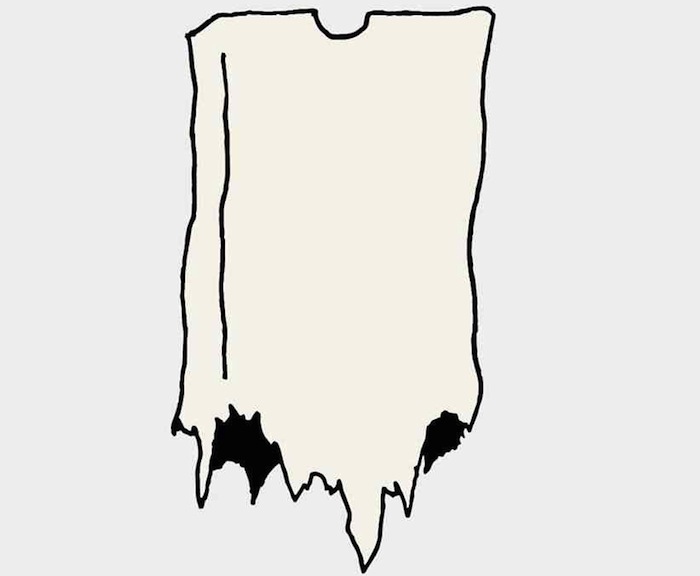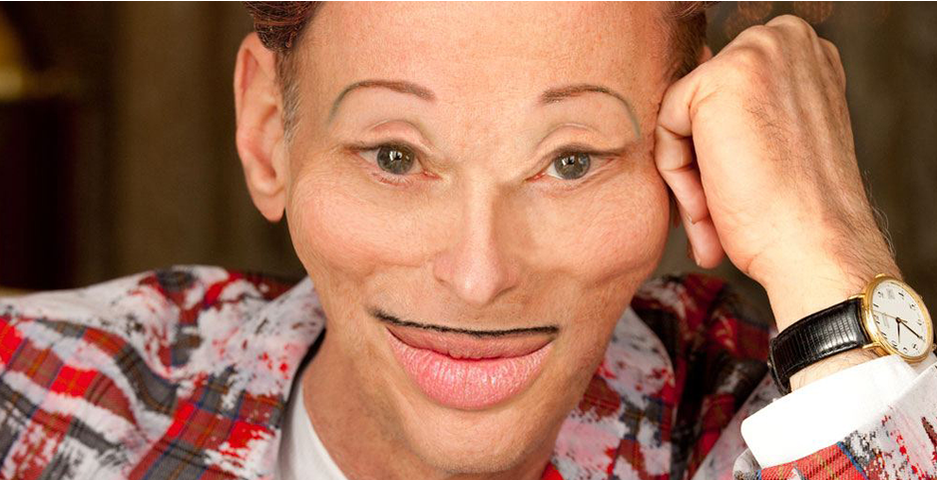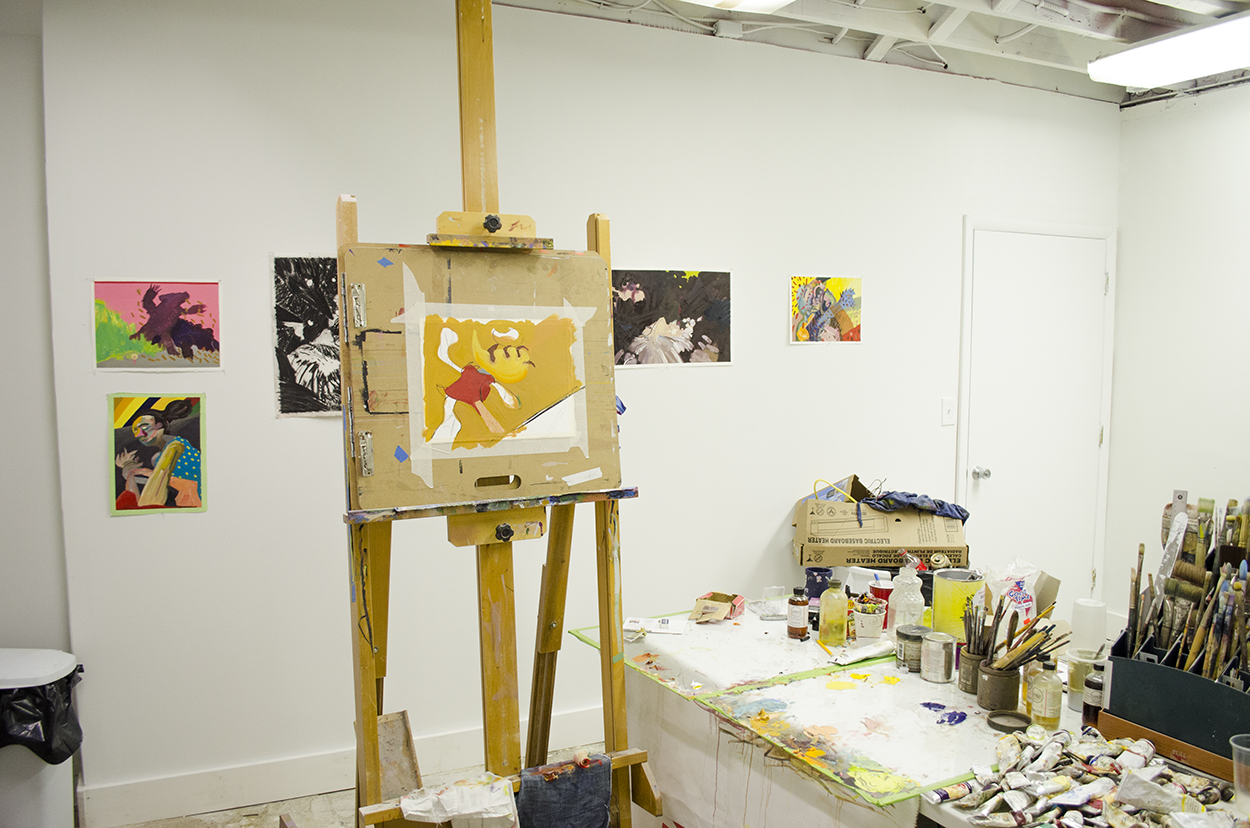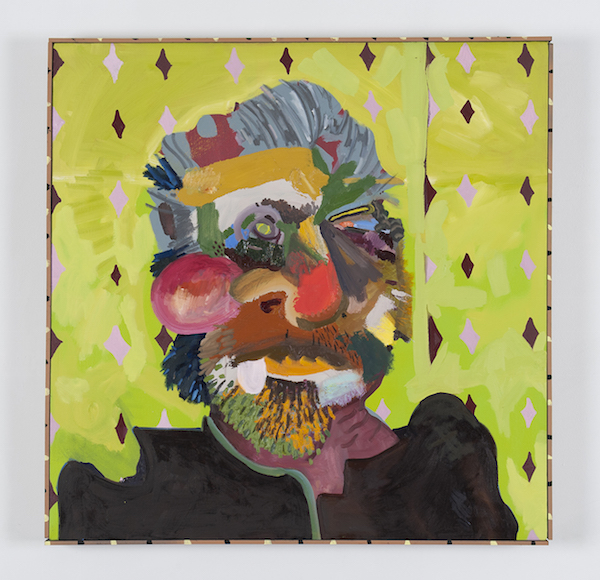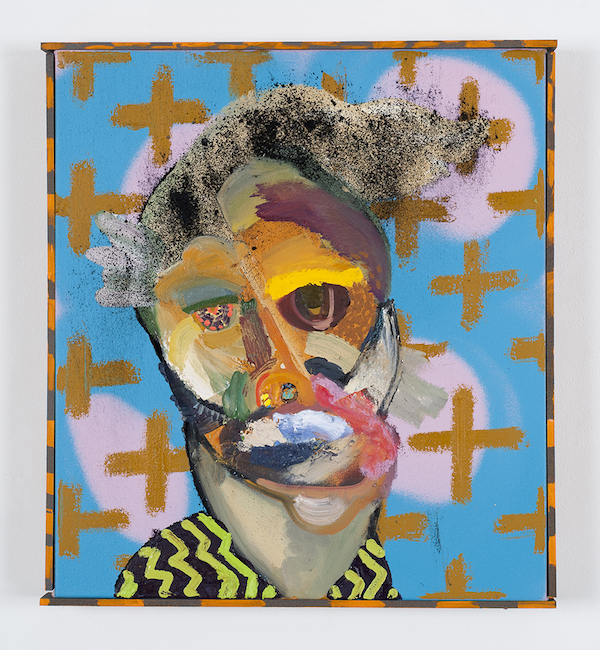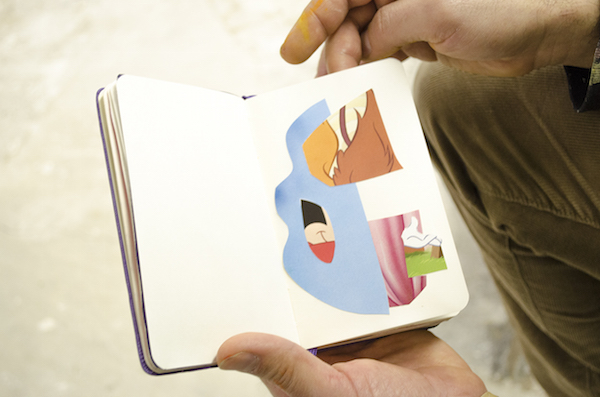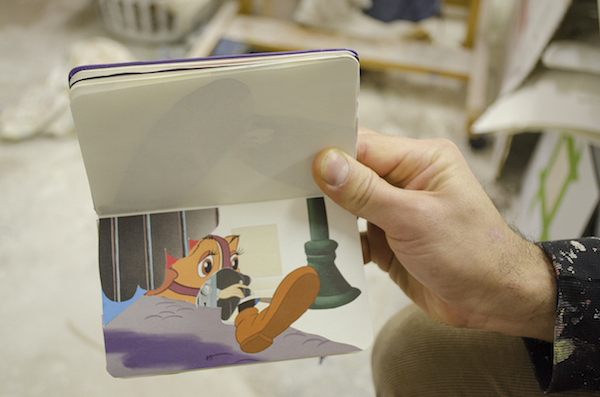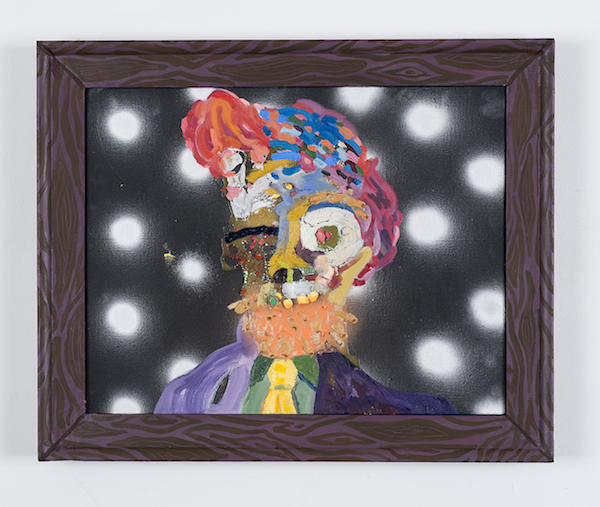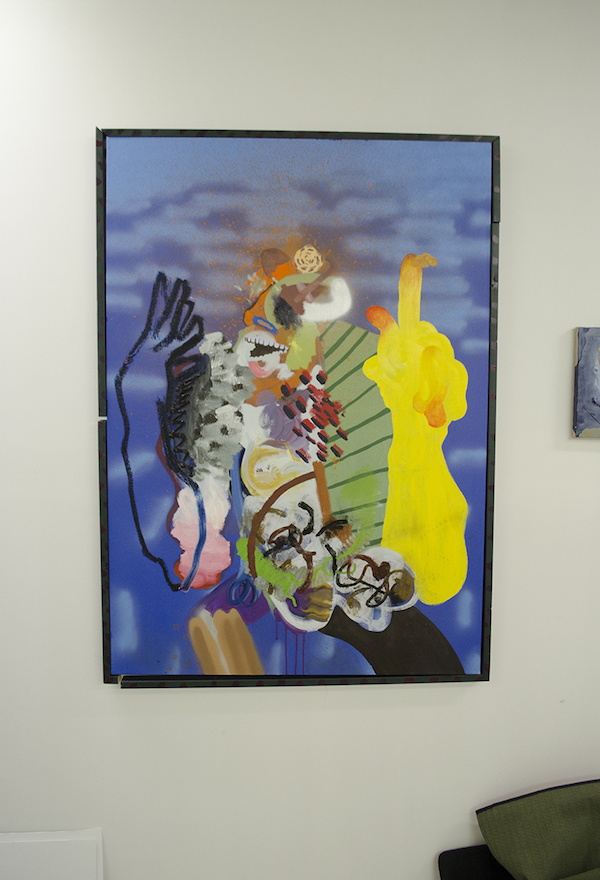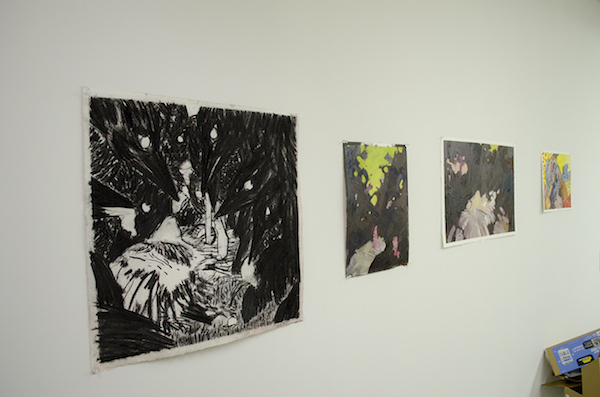Ali Seradge, originally from Oklahoma, received his MFA from MICA in 2014 after studying at SAIC. He has had exhibitions in Chicago, Washington, D.C., and Baltimore. He recently moved into the new K-town Studios and is working on an installation in the Station North Arts District. He had me over to his studio to look at some of his work. Here is a part of that conversation.
Dwayne Butcher: You have created numerous works around the “Parlor Room” and how it used to function. How did your interest in this subject happen?
Ali Seradge: I was doing these imaginary portraits and began to view the subjects as a family. A weird made up family. So families, homes, and how they were presented were all on my mind. In 19th Century Western Europe, the parlor room was a place where a family showed its face to the world. There were parlors before then, but the 19th century really takes the patterning and decor to another level. Wakes, receptions, heirlooms, and artifacts were displayed in this room.
Aside from ascribing family history and heritage, the quality of the art would be used to indicate the homeowner’s status. My subjects have no such hope; they are crass and ill mannered, as is any room they would inhabit. I think that this group of weirdos puts together a parlor room, gives them a bit of nobility. That, even if they hate each other, they still stand together against everyone else. That’s the offensive side to that parlor. You invite people over to intimidate them with your money and power.
DB: How did the use of the patterned mural come about in regards to this work and how is that pattern decided?
AS: I view it more of a painted wallpaper than even a mural. The idea of patterning really took off from the idea of decoration. It’s funny, back in school, one of the biggest insults you could give a painter was to call their work “decorative.” Ornamentation has significance. People were and are very serious about it, especially patterns. Clan identification, heraldry, medals, flags and more all have meanings or intent. I wanted the parlor rooms I made to have that consideration.
The pattern I decided on was that of various snake skins. One of my favorites was of the Western Diamondback Rattlesnake. It reminds me of my home state, Oklahoma. It is an animal feared around the southwest United States. People also make boots and clothing out of them. That’s the mentality I wanted for the wallpaper. An animal chosen for it’s power and used symbolically and decoratively. I also like what our preconceived notions about snakes implies about the portraits.
DB: You state that, “a relic in its home is more satisfying than seeing it in a museum or gallery,” and that “art is becoming so far removed from the average viewer/average person.” Can you expand on these statements and how it affects your work?
AS: Oh wow, I need to stretch out so I can put my foot in my mouth here. A battle axe in a museum has a certain coolness to it, an almost Pop Art recontextualization, an academic safety. When it is someone’s home, and the main explanation is my ancestor killed a bunch of people with this in The Crusades, it is closer to its purpose. Like all art, the closer it is to the intended purpose the more powerful it is. This is simple site specificity. The axe is most powerful on the battlefield. The decorative sword serves best in parade as a symbol of rank. Conversely, a giant painting made with a museum in mind will look absurd in a rustic cottage. I *try* to keep that in mind when making my work. That’s why I made the parlors live with the portraits.
Much of the art made today, is not made with the purpose of reaching the “average viewer.” Part of this has to do with how art production is funded, but invariably it comes to the artist’s intention. If you make something that takes a stand and communicates clearly to people you get labeled as “political” or dare I say “illustrative.” Why those are considered pejorative I can’t really comprehend. It seems like a lot of artists make work for collectors, grants, and institutions. Which I completely understand, that’s where the money is. I think about it all the time, but I also remember myself before art school.
I was challenged a lot, but I felt the most reward when there was a thread or clue that led me somewhere. I think artists, especially painters, are disillusioned by the “17 second look.” They (and often me) feel in the world of screens, if the average viewer is going to spend 17 seconds or less looking at a painting, why bother with reaching out to those viewers? It is a two way street really, we have to adapt and maximize that brief window. I think that brand of cynicism is how painter’s started doing paintings about painting. There are way too many people doing that.

DB: How did you transition from the parlor room pieces to the new biblical works?
AS: It came from a desire to make multi-figure compositions using the same techniques in the portraits. I had to keep in mind that my figures were painted in such a way, that they could never be real people. This opened up an interesting avenue. Biblical paintings served an illustrative and mimetic purpose. People believed that those stories happened, so they needed to be diagramed or painted in such a way that the story would be clear and real. Which bring us to a paradox. If a deity of any kind appears, and performs an astounding feat no less, then the assumption that the narration is accurate cannot be sustained.
When we think of “fire from heaven” as it is stated in Kings 2, can we assume that is actual fire? Or is it more likely that it is something absolutely otherworldly and terrifying, originating from a being who is utterly beyond our scope, and that “fire” is the closest thing an eyewitness could muster. I am firmly rooted in the second camp. We can assume gods inhabit different dimensions than us. As such, everything reality based should be suspect when they or their actions are present. The depiction (or approximation) of such moments is the last place where painting can keep up with other media. Celebrating the fact that language is failing in the “weirder” Bible stories is a kind of celebration of the things beyond our scope, Christian and otherwise.
DB: Why is Lot’s Wife’s punishment a weird punishment? And why is it she is never named?
AS: She is named!!!! Depending on whom you ask, the name is Ado, Edith, or Ildith. I personally am fond of Ildith. The Bible leaves her unnamed, though. It is super weird. The whole story is wild. Her only crime is looking back. At what? God destroying her home in what we can only assume is the Fourth of July times a billion. It also never says why she looks back. One tradition states she is being punished for longing after her old way of life. That doesn’t make sense. They (the angels) would not have let her flee if she was a huge rape fan, like the Sodomites. Let’s be clear here, Sodom’s judgment has nothing to do with butt sex and everything to do with raping and murdering guests in your city. And also, why a pillar of salt? Cities are being blasted, just throw her in if you want? Order Lot to kill her. There are infinite ways to kill Ildith, but a pillar of salt was what the wheel landed on. Maybe to leave her as a warning? Warning of what? To whom? Which brings me back to my point: turned to a pillar of salt may be an approximate term for something much stranger.
DB: When creating these biblical works, how does dimensionality play a role?
AS: I’m really caught up in this idea. It’s like Abbott’s Flatland. We can hypothesize if there are beings that operate in dimensions unlike our own and are not constrained by our limits. I don’t think it is unreasonable to suggest our perceptions or senses would short circuit when one of them showed up. Especially if that creature’s will was manifested in our reality.
Let’s think about it, we get fucked up by jet lag. Jet lag. Time Dilation? Potentially traumatizing but explainable. Now imagine something that manipulates time like we do shows up and starts doing things. That, like the European Pantheons, they are consulate shape shifters. Sheer madness. I hope.
DB: Why should they make a movie about Elijah?
AS: He is the biblical sci-fi anti-hero. He calls down fire to burn enemy soldiers as a PREEMPTIVE STRIKE! Not once, but three times in a row. This is after the first time fire came down from heaven in his contest against the prophets of Baal. He also gets fed by ravens on one journey. Remember that ravens are huge and sometimes eat rotting dead things. One of my favorites is that when some kids make fun of Elijah for being bald. Elijah cursed them and two she-bears mauled ALL 42 CHILDREN to death. You could make an art house movie about each one or a summer blockbuster of all of them. Send me royalties.
DB: Your website, monkeychainsaw.com is a digital project space for your work. What do you think of the electronic/digital media as a realm for artists?
AS: I feel like the majority of Internet art and design is trying to be analogous to an existing medium. Remember when “virtual reality” was a buzz phrase? It implied that anything in the digital realm should strive to be a perfect translation or reinterpretation of our “reality.” This is stupid on two levels. One: the digital is encompassed in our reality because it exists within our physical planes. It is no more extradimensional than a painting. They both are made of atoms organized and perceived. The previous axiom brings us to the second point: the digital becomes a medium. It is a reordering and application of physical components (conductors, electrons, plastics, etc.) to create a signifier.
The problem with digital media is that we are trying to use it in many of the ways we use older media. We show our paintings on the Internet in the hope it will give someone the experience of being in front of it, knowing full well success is only measured by how little we fail. Depressing. Let’s use the digital as a medium of its own! How long have people been manipulating rocks? We have some pretty good ideas of its capabilities for art. I feel like digital media, especially the Internet, have barely been touched. My stuff online is an extremely basic foray into that. The animated gifs I made live on the digital realm and only there. I will never bring them into a “traditional” medium. As I go, I will try and do more things that won’t make sense outside a digital screen. I remember Maurice Rapf lamenting the animation that tried too hard to be “realistic.” He thought that if the medium allowed you to depart reality, you should definitely take it in that direction. I still think about that a lot.
DB: How do you think about the gifs you create and how can this media ever integrate into the physical world?
AS: I do! And I want to avoid bringing my digital creations into another medium at all costs (but not the other way around.) I feel like animated gifs work best when they cycle well. In that regard they are more like a thaumatrope with more than two states. We need our digital creations to take advantage of their medium specificity. Right now, with apps blowing up, everyone seems to think interactivity is that delineating factor. I’m not sure, but I am curious to see.
DB: You are also interested in the idea of synesthesia. Is this something that can bridge the gap, or help to bridge the gap between the physical and the digital worlds?
AS: I’m not sure if the digital space can bridge two senses. It is an interesting idea. Like creating a body suit that tingles a certain way depending on the colors around you. You could create a color sensing skin. I feel that the digital realm provides an interesting way to gather, filter, translate, and emit huge amounts of information. The way it is packaged and delivered also influences those sensations. I really feel like that is one of the specific things about digital media.
DB: What projects and/or exhibitions do you have coming up in the new year?
AS: I’m always working in the studio. I have been making collage books. The pages I like the most get their chance at being small paintings. Then, maybe, they grow to bigger ones. The animated gifs are going to keep coming. Let’s see. Oh! We have a collaboration of Katie Duffy, Dave Eassa, myself, and Station North Arts District for the Koban Project. We are going to create a piece related to surveillance. We are not saying it is good or bad thing. We would like people to think about what makes them comfortable and/or uneasy in regards to being watched. I am most curious about whether people want to know who is watching them? How does community-policing work in a wired society? That’s all the small stuff coming out of me. 🙂
Dwayne Butcher is an artist, writer, curator and chicken wing connoisseur living in Baltimore, MD. Butcher moved here from Memphis in the summer of 2013. In that time he has continued to have international exhibitions, published articles in local, regional and national publications, and curated an exhibition of Baltimore-area artists titled “Bawlmer” at Crosstown Arts in Memphis, TN. To see his work and curatorial projects, visit his website and follow him on twitter @dwaynebutcher.
